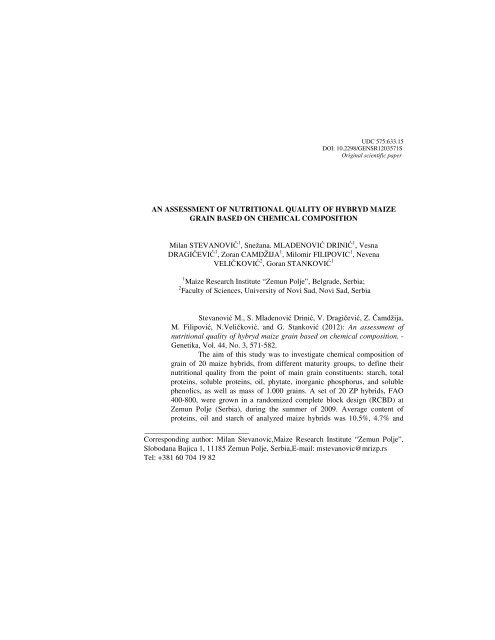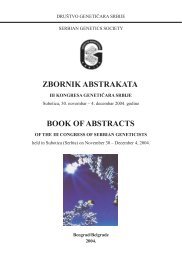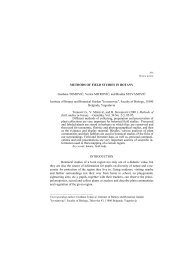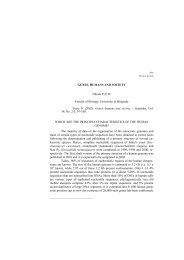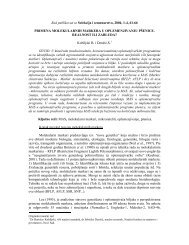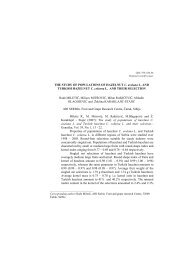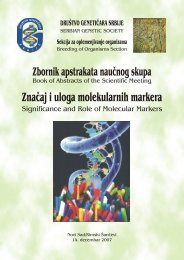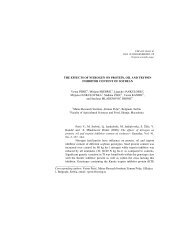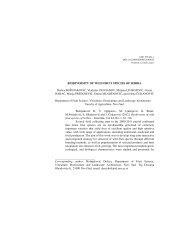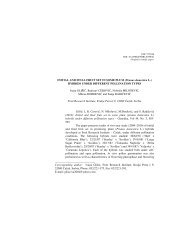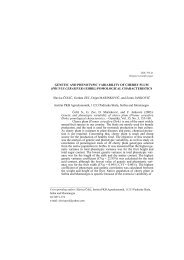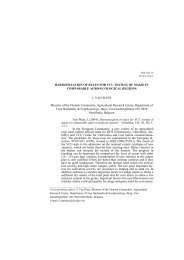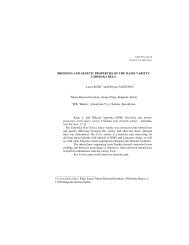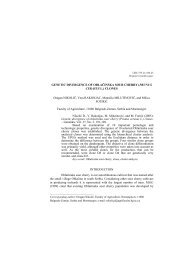Milan Stevanovic,Maize Research Institute “Zemun Polje” - doiSerbia
Milan Stevanovic,Maize Research Institute “Zemun Polje” - doiSerbia
Milan Stevanovic,Maize Research Institute “Zemun Polje” - doiSerbia
Create successful ePaper yourself
Turn your PDF publications into a flip-book with our unique Google optimized e-Paper software.
UDC 575:633.15<br />
DOI: 10.2298/GENSR1203571S<br />
Original scientific paper<br />
AN ASSESSMENT OF NUTRITIONAL QUALITY OF HYBRYD MAIZE<br />
GRAIN BASED ON CHEMICAL COMPOSITION<br />
<strong>Milan</strong> STEVANOVIĆ 1 , Snežana. MLADENOVIĆ DRINIĆ 1 , Vesna<br />
DRAGIČEVIĆ 1 , Zoran CAMDŽIJA 1 , Milomir FILIPOVIC 1 , Nevena<br />
VELIČKOVIĆ 2 , Goran STANKOVIĆ 1<br />
1 <strong>Maize</strong> <strong>Research</strong> <strong>Institute</strong> <strong>“Zemun</strong> <strong>Polje”</strong>, Belgrade, Serbia;<br />
2 Faculty of Sciences, University of Novi Sad, Novi Sad, Serbia<br />
Stevanović M., S. Mladenović Drinić, V. Dragičević, Z. Čamdžija,<br />
M. Filipović, N.Veličković, and G. Stanković (2012): An assessment of<br />
nutritional quality of hybryd maize grain based on chemical composition. -<br />
Genetika, Vol. 44, No. 3, 571-582.<br />
The aim of this study was to investigate chemical composition of<br />
grain of 20 maize hybrids, from different maturity groups, to define their<br />
nutritional quality from the point of main grain constituents: starch, total<br />
proteins, soluble proteins, oil, phytate, inorganic phosphorus, and soluble<br />
phenolics, as well as mass of 1.000 grains. A set of 20 ZP hybrids, FAO<br />
400-800, were grown in a randomized complete block design (RCBD) at<br />
Zemun Polje (Serbia), during the summer of 2009. Average content of<br />
proteins, oil and starch of analyzed maize hybrids was 10.5%, 4.7% and<br />
____________________________<br />
Corresponding author: <strong>Milan</strong> <strong>Stevanovic</strong>,<strong>Maize</strong> <strong>Research</strong> <strong>Institute</strong> <strong>“Zemun</strong> <strong>Polje”</strong>,<br />
Slobodana Bajica 1, 11185 Zemun Polje, Serbia,E-mail: mstevanovic@mrizp.rs<br />
Tel: +381 60 704 19 82
572 GENETIKA, Vol. 44, No.3, 571-582, 2012<br />
80.8%, respectively. Hybrids from FAO maturity group 600 had highest<br />
grain mass (in average 419.5 g). Genetic variability in seed phytate content<br />
was observed, with values ranging from 2.64 to 3.75, averaged 3.44 g kg -1 .<br />
Inorganic phosphorus (Pi) concentrations were between 0.120 µg g -1 (ZP<br />
805) to 0.415 µg g -1 (ZP 588ex), averaged 0.24 µg g -1 . Content of soluble<br />
proteins varied from 54.33 to 78.74 mg g -1 . The high positive correlation<br />
was observed between total proteins and oil content in hybrids, as well as<br />
between starch and phenolics content. Phytate content was positively<br />
correlated with proteins, but this correlation was not significant, while the<br />
correlation between phytate and mass of 1,000 grains was positive and<br />
significant. A negative correlation occurred between phytate and starch.<br />
Key words: grain content, maize, nutritional value<br />
INTRODUCTION<br />
Grain quality is a wide term that means different things to corn producers,<br />
crop consultants, dairy producers or ruminant and human nutritionist. From the<br />
nutritional point of view corn grain such as fat, protein, hardness, density, and starch<br />
content define corn quality characteristics. Chemical content of maize grain is very<br />
important for human and animal diets. Average content of proteins, oil and starch in<br />
maize seed is 9%, 4%, 73%, respectively (BALCONI et al., 2007). Some breeding<br />
programs are routing the specific traits for different usage of maize grain, such as<br />
increasing of oil, protein or starch content in grain (SALEEM et al., 2008; ROSULJ et<br />
al., 2002, POLLAK and SCOTT, 2005, HARRELSON et al., 2008, IDIKUT et al., 2009).<br />
The interaction between different components of maize grain could induce<br />
different digestibility of each compound, what could also define nutritional quality of<br />
maize grain. HOFFMAN and SHAVER (2011) defined basic properties of nutritional<br />
quality of maize grain as feedstuff. Dry grain of flint and dent genotypes contains<br />
more hydrophobic prolamin-zein as compared to floury or opaque corns. The crude<br />
protein, prolamin protein is negatively related to starch degradability. The cultivars<br />
with higher content of crude protein had higher digestibility coefficient of these<br />
nutrients, while the nitrogen balance and retention were not influenced by cultivar<br />
(JAN et al., 2008). ZILIC et al. (2011) ascertained that the highest nutritive value was<br />
recorded in sweet maize hybrids, but the low starch and lignin content affected dry<br />
matter digestibility.<br />
Most of the phosphorus in maize grain is not nutritionally available to<br />
animals and humans, because it is stored in phytic acid that cannot be digested by<br />
monogastric animals because they lack the enzyme phytase needed to utilize this P<br />
form. Nearly all the phytic acid found in mature seeds is bound to minerals in form a<br />
mixed cation salt – phytate (LOTT et al., 2000) and could also form protein-phytate<br />
insoluble complexes, considering it as a limiting factor to protein utilization. From<br />
that point of view, P bioavailability in maize diets is only 15% for monogastric<br />
animals. Most of the endogenous P in the diets of swine and poultry passes into the<br />
feces and onto the landscape, where it contributes to surface water pollution. Such<br />
contamination can cause eutrophication in aquatic ecosystems, promoting
M. STEVANOVIC et al.: CHEMICAL COMPOSITION OF HYBRID MAIZE GRAIN 573<br />
algalblooms and reducing available oxygen for macro-organisms (ERTL et al., 1998).<br />
On average, swine need 2.35 g Pi kg -1 dietary dry matter to meet their nutritional<br />
requirements (KNOWLTON et al., 2004), and phytate levels should be as low as<br />
possible to minimize P pollution. Therefore, it would be desirable to increase the<br />
concentration of inorganic P as an available P form, and reduce the phytate<br />
concentration in maize grain to help alleviate the associated nutritional and<br />
environmental problems simultaneously. Low phytate maize is receiving<br />
considerable attention as a means of minimizing manure-P, with increasing<br />
availability of P and Ca (CAST, 2002; RABOY et al., 1997). Animal feeding trials<br />
have shown that P availability is greatly improved in low phytate maize genotypes<br />
leading to substantial decreases in feces P concentration (KNOWLTON et al., 2004;<br />
HILL et al., 2009; BOHLKE et al., 2005).<br />
Bound phenolics in grains are associated with cell wall fiber or protein and<br />
escaped gastric and small intestine digestion. Soluble phenolics could form<br />
indigestible protein-phenolics complexes, what could limit protein utilization.<br />
Meanwhile, soluble phenolics, which could be potentially absorbed in small intestine<br />
and contributes to the antioxidant activity of body tissues (KLJAK et al., 2009).<br />
The aim of this study was to investigate chemical composition of grain of 20<br />
maize hybrids, from different maturity groups, to define their nutritional quality from<br />
the point of main grain constituents: starch, total proteins, soluble proteins, oil,<br />
phytate, inorganic phosphorus, and soluble phenolics, as well as mass of 1,000<br />
grains.<br />
MATERIALS AND METHODS<br />
A set of 20 ZP hybrids, FAO 400–800, were grown in a randomized complete<br />
block design (RCBD) at Zemun Polje (Serbia), during the summer of 2009. The<br />
hybrids were allowed to open pollinate, and two rows were hand-harvested to collect<br />
grain samples. Total protein, oil, starch, phytate, Pi, phenolics and soluble protein<br />
content were measured. Seed protein, oil and starch content were determined by<br />
near-infrared reflectance spectroscopy (NIRS) using Infratec 1241 Grain analyzer,<br />
(Foss Tecator, Sweden) and expressed in a percentage of absolutely dry matter of<br />
grain (ADM). Seeds for phytate, Pi, phenolics and soluble proteins were grinded in a<br />
TecatorKnifetec 1095 sample mill (particle size 0.5 mm) and then the extraction was<br />
performed with double distilled water (DD H2O). Phytate was determined<br />
colorimetrically by the method of LATTA and ESKIN (1980), modified by SREDOJEVIC<br />
and DRAGICEVIC (2009), based on the pink color of the Wade reagent, which is form<br />
upon the reaction of ferric ion and sulfosalicilic acid, and has an absorbance<br />
maximum at λ=500 nm. In the presence of phytate, the iron is sequestered and<br />
unavailable to react with sulfosalicylic acid, resulting in a decrease in pink color<br />
intensity. Inorganic P (Pi) was determined according to POLLMAN (1991) with<br />
ammonium heptamolybdate + ammonium metavanadate reagent, while the content<br />
of soluble proteins was determined by LOWRY et al. (1951), using the the Folin-<br />
Phenol reagent. Content of total soluble phenolics were determined by the method of<br />
SIMIC et al. (2004, 2005) with Prussian blue assay. Mass of 1.000 grains was<br />
determined gravimetrically.
574 GENETIKA, Vol. 44, No.3, 571-582, 2012<br />
The experimental data were statistically processed by analysis of the variance<br />
(ANOVA) in program package MSTAT-C and analyzed by the LSD-test (5%).<br />
Correlations for mean values of chemical components maize grain were determined<br />
in program package STATISTICA 10 by using option Spearman Rank Order<br />
Correlations. Relations between different grain constituents were presented<br />
graphically, using MINITAB 14 software.<br />
RESULTS AND DISCUSSION<br />
Grain chemical composition is the most important trait to the end-use quality<br />
of maize. Analysis of variance (ANOVA) showed that all analyzed characteristics<br />
were significantly different at level p = 0.05. It is well known that total protein<br />
composition varies among genotypes (LORENZ et al., 2007; MLADENOVIC DRINIC et<br />
al., 2009). The total protein of 20 ZP hybrids ranged from 8.0% in ZP 805 to 14.0%<br />
in ZP 588ex, with average value of 10.5% (Table 1).<br />
The highest protein content has hybrids from FAO 500, while the protein<br />
content is significantly decreasing with increase of maturity group. The oil content<br />
ranged from value of 4.1% (ZP 653ex) to 5.4% (ZP 666), with average value of<br />
4.7%. The highest average oil content has hybrids from FAO 400, as well as ZP 666<br />
and ZP 708ex. According to fact that starch is main constituent of maize grain<br />
(BALCONI et al., 2007), it content ranged from 77.4% (ZP 588ex) to 84.8% (ZP 768),<br />
with average content of 80.8%. ZP hybrids belonging to FAO 800 have the highest<br />
starch content, but the lowest content of total protein, indicating different endosperm<br />
constitution (GOOSSENS et al., 1988). Obtained values for protein, oil and starch are<br />
typically for maize genotypes that were not specifically selected for those traits<br />
(POLLAK and SCOTT, 2005; HARRELSON et al., 2008; IDIKUT et al., 2009). The mass<br />
of 1.000 grains varied upon hybrids from 284.7 g (ZP 753 ex) to 467.7 g (ZP 606).<br />
FAO maturity group 600 is characterized with highest grain mass (in average 419.5<br />
g). The highest grain mass in hybrids that belongs to same FAO maturity group was<br />
also reported by STEVANOVIC et al (2012).<br />
Substantial quantitative variation in phytate has been observed among ZP<br />
hybrids (Table 2). The phytate content varied from 2.64 µg g -1 to 3.75 µg g -1 ,<br />
averaged 3.44 µg g -1 . In general, hybrids from FAO 800 maturity group had the<br />
lowest phytate content (in average 2.89 gkg -1 ), what could serve as a low-phytic feed<br />
in nutrition and processing (BOHLKE et al., 2005). Inorganic phosphorus (Pi) is<br />
important form of phosphorus in grains, although it is present at relatively low<br />
concentrations and thus constitutes a small fraction of the total P of grains. High<br />
level of inorganic P is regarded as desirable form a nutritional standpoint. Among<br />
hybrids Pi content ranged from 0.120 µgg -1 (ZP 805) to 0.415 µgg -1 (ZP 588ex),<br />
averaged 0.24 µg g -1 . The highest Pi content was obtained in ZP 588 ex (0.415µgg -1 ).<br />
Both phytate and Pi values were within the range of values reported for maize<br />
hybrids in previous study (RABOY et al., 2000), but hybrids with lower phytate<br />
content did not match higher Pi contents, as desirable P form. Content of soluble<br />
proteins ranged from 54.33 mg g -1 in hybrid ZP 846ex to 78.74 in hybrid ZP 341,<br />
with average value of 64.45 mg g -1 (Table 2). The observed values mark up that
M. STEVANOVIC et al.: CHEMICAL COMPOSITION OF HYBRID MAIZE GRAIN 575<br />
content of soluble proteins in total protein content could vary in wide range: from<br />
52%, present in hybrids ZP 588ex and ZP 666, up to 86% in ZP 805. Such situation<br />
could indicate different digestibility and potential of grain usage (BARTECZKO et al.,<br />
2008; ZILIC et al., 2011). Soluble phenolics have value from 421.5 µg g -1 in hybrid<br />
ZP 555 to 557.3 µg g -1 in ZP 805 with average value of 485.35 µg g -1 .<br />
Table 1. The content of Total proteins, Oil, Starch and Mass of 1000 grains of 20 ZP hybrids<br />
(FAO 400-800) and ANOVA for analyzed characteristics<br />
Hybrid<br />
Total Proteins<br />
%<br />
Oil<br />
%<br />
Starch<br />
%<br />
Mass of 1000<br />
grains<br />
g<br />
ZP 341 10.05 HI 4.30 FG 79.05 EFG 418.0 C<br />
ZP 434 11.70 BCD 4.90 CDE 79.40 EFG 324.7 O<br />
ZP 444 ex 10.30 GHI 5.15 ABC 78.55 FG 410.4 E<br />
ZP 484 ex 10.35 FGHI 5.00 BCD 81.65 BC 360.4 K<br />
ZP 555 11.15 CDEF 4.50 EF 80.15 DE 377.7 H<br />
ZP 560 11.75 BC 4.95 BCD 78.40 GH 412.0 D<br />
ZP 588 ex 14.00 A 5.05 ABC 77.40 H 398.7 F<br />
ZP 600 ex 9.90 HIJ 4.40 FG 81.55 BC 454.0 B<br />
ZP 606 9.75 IJ 4.30 FG 80.70 CD 467.7 A<br />
ZP 653 ex 10.65 EFGH 4.05 G 81.75 BC 363.7 J<br />
ZP 666 11.40 BCDE 5.45 A 79.65 DEF 392.8 G<br />
ZP 708 ex 12.05 B 5.35 AB 78.55 FG 303.3 Q<br />
ZP 728 ex 11.00 CDEFG 4.60 DEF 80.65 CD 365.2 J<br />
ZP 753 ex 9.65 IJ 4.35 FG 82.20 B 284.7 R<br />
ZP 768 8.50 KL 4.25 FG 84.75 A 367.6 I<br />
ZP 801 ex 10.60 EFGH 5.30 ABC 82.30 B 328.7 N<br />
ZP 805 8.00 L 4.50 EF 82.55 B 325.0 O<br />
ZP 808 8.35 KL 4.25 FG 82.35 B 313.1 P<br />
ZP 836 10.90 DEFG 5.05 ABC 81.50 BC 347.3 L<br />
ZP 846 ex 9.10 JK 4.25 FG 82.40 B 344.7 M<br />
Average 10.5 4.7 80.8 349.43<br />
LSD 0.05 0.83 0.40 1.12 1.54<br />
A-L Means followed by the same letter within the same columns are not significantly different (p < 0.05)
576 GENETIKA, Vol. 44, No.3, 571-582, 2012<br />
Table 2. The content of P i, Phytate, Soluble Proteins and Phenolics of 20 ZP hybrids (FAO<br />
400-800) and ANOVA for analyzed characteristics<br />
Hybrid<br />
Phytate<br />
µg g -1<br />
Pi<br />
µg g -1<br />
Sol. Proteins<br />
mg g -1<br />
Phenolics<br />
µg g -1<br />
ZP 341 3.580 ABC 0.210 EFGHI 78.74 A 546.5 AB<br />
ZP 434 3.300 CDEF 0.260 CDE 60.99 FG 478.0 DEFGH<br />
ZP 444 ex 3.190 DEFG 0.300 BCD 69.49 BC 432.9 GHI<br />
ZP 484 ex 3.120 FG 0.235 DEFGH 68.49 C 472.2 DEFGH<br />
ZP 555 3.390 CDEF 0.210 EFGHI 68.76 C 421.5 HI<br />
ZP 560 3.540 ABC 0.190 FGHI 66.72 CD 444.4 FGHI<br />
ZP 588 ex 3.405 CDE 0.415 A 72.62 B 479.4 DEFGH<br />
ZP 600 ex 3.180 DEFG 0.175 HIJ 68.66 C 471.5 DEFGH<br />
ZP 606 3.450 BCD 0.255 CDEF 59.01 GH 447.2 EFGHI<br />
ZP 653 ex 3.710 AB 0.220 EFGHI 64.80 DE 503.7 ABCDE<br />
ZP 666 3.335 CDEF 0.250 CDEF 59.29 GH 408.7 I<br />
ZP 708 ex 3.445 BCD 0.350 AB 56.69 HI 519.4 ABCD<br />
ZP 728 ex 3.140 EFG 0.225 EFGH 59.90 FGH 452.2 EFGHI<br />
ZP 753 ex 3.245 DEFG 0.310 BC 63.20 EF 550.8 AB<br />
ZP 768 3.755 A 0.245 CDEFG 60.11 FGH 540.8 ABC<br />
ZP 801 ex 3.425 CD 0.155 IJ 69.15 C 452.2 EFGHI<br />
ZP 805 2.990 G 0.120 J 69.37 BC 557.3 A<br />
ZP 808 2.695 H 0.180 GHIJ 60.11 FGH 551.5 AB<br />
ZP 836 2.70 H 0.205 EFGHI 58.63 GH 483.0 CDEFG<br />
ZP 846 ex 2.640 H 0.270 CDE 54.33 I 493.7 BCDEF<br />
Average 3.26 0.24 64.45 485.35<br />
LSD 0.05 0.281 0.066 3.44 58.6<br />
A-L Means followed by the same letter within the same columns are not significantly different (p < 0.05)<br />
Correlations were calculated to identify trait relationships that should be<br />
considered during the process of improving germplasm, as well as to compare our<br />
results with previously reported correlations to determine if similar relationships<br />
exist. The significant and positive correlation between total protein and oil content<br />
was observed (Table 3). This is in agreement, with findings of SONG and CHEN<br />
(2004), FABIJANAC et al (2006) and DADLEY et al. (2007). ALDA et al (2011) found<br />
positive correlation between protein and oil content of eight maize hybrids of various<br />
maturity groups. ABOU DEIF et al. (2012) found negative correlation between protein
Total<br />
Proteins<br />
M. STEVANOVIC et al.: CHEMICAL COMPOSITION OF HYBRID MAIZE GRAIN 577<br />
and oil contents in majority of studied maize inbred lines. Three inbred lines out of<br />
14 as well as 4 crosses out of 15 had high protein and oil content. The negative<br />
significant correlation between total protein and starch content was obtained as it<br />
was expected (CLARK et al., 2006; DUDLEY et al., 2007; HARRELSON et al 2008,<br />
ZHANG et al., 2008, IDIKUT et al. 2009). COOK et al (2012) evaluated nested<br />
association mapping population and the 282 IL association panel for starch, protein<br />
and oil content. In both the NAM population and AP significant positive correlation<br />
were detected between protein and oil content and highly significant negative<br />
correlation between starch and both protein and oil.<br />
Table 3. Correlation between main grain constituents of 20 ZP maize hybrids<br />
Total<br />
Proteins<br />
Oil 0,60748* 1<br />
1<br />
Starch -0,75569* -0,51140* 1<br />
Oil Starch Pi Phytate Sol. protein Phenolics<br />
Pi 0,26488 0,14395 -0,36502* 1<br />
Phytate 0,28378 0,01450 -0,27113 0,09196 1<br />
Sol.<br />
protein<br />
0,00169 0,07415 -0,22561 -0,24074 0,22811 1<br />
Phenolics -0,46096* -0,42075* 0,42132* 0,02688 -0,02088 -0,07940 1<br />
Mass on<br />
1000<br />
grains<br />
* p
578 GENETIKA, Vol. 44, No.3, 571-582, 2012<br />
(URIBELARREA et al., 2004). This may be supported by a negative correlation<br />
between 1000 kernal weight and oil content in our research also reported by<br />
FABIJANAC et al. (2006).<br />
As in many previous reports (LORENZ et al., 2007, 2008; DRINIC et al., 2009),<br />
phytate content in maize grain was positively correlated with proteins (r=0.28). In<br />
our study, mentioned correlation was not significant, while the correlation between<br />
phytate and mass of 1.000 grains was positive and significant. A negative correlation<br />
occurred between phytate and starch (r=-0.27). These findings is in agreement with<br />
findings of HARLESON et al. (2008), IDIKUT et al. (2009), LORENZ et al. (2008), who<br />
found negative relationship between starch and phytate. This result reflects the seed<br />
deposition pattern of phytate, where approximately 90% of phytate is found in the<br />
germ and only trace amounts are in the endosperm. In Figure 1D results of dealings<br />
between phytate, total protein and starch content emphasize that the highest phytate<br />
content was found in hybrids with total protein content in range 9.5 – 10.5%, as well<br />
as starch content in range 79.5 – 80.5%. Hybrids that have the low phytate<br />
concentration have also the highest starch content, but lower protein content than<br />
average. Similar to phytate, the correlation between starch and Pi was significantly<br />
negative (r=-0.36). The highest Pi content was also observed in hybrids with higher<br />
contents of proteins, as well as hybrids with relative high starch content and low<br />
protein content (Fig. 1E), indicating that breeding course for low phytate genotypes<br />
(CAST, 2002; RABOY et al., 1997) isn’t the only way for increasing of Pi content, as<br />
digestible P form.<br />
Additionally, the significant negative correlation was observed between total<br />
protein content and phenolics and in combination with seed mass emphasizing that<br />
seeds with lower mass had lower phytate content, as well as higher content of<br />
phenolics (> 500 µg g -1 , Fig. 1B).<br />
The observed results could indicate positive traits for breeding programs<br />
because of well-known formation of indigestible protein-phenolics and proteinphytate<br />
complexes, what is the major limiting factor to protein utilization. Moreover,<br />
the significant positive correlation was obtained between starch and phenolics, as<br />
well as, the significant negative correlation between total proteins and phenolics,<br />
what could stress that relative high content of phenolics could be expected in hybrids<br />
with high content of total proteins and low starch content and in some degree in<br />
hybrids with high starch content and low protein content (Fig. 1E).<br />
In conclusion, obtained values for protein, oil and starch are typically for<br />
maize genotypes that were not specifically selected for those traits. It s important to<br />
underline that hybrids from FAO 500 had the highest protein content, while the<br />
hybrids from FAO 800 have the highest starch content and the lowest content of total<br />
protein and phytate, indicating different endosperm constitution and potential usage.<br />
Moreover, the seeds with highest mass have total protein content in range 9-10% and<br />
starch content in range 80.5- 82% with lower values of phytate content and higher<br />
values of phenolics, what could serve as basis for further breeding programs, which<br />
include hybrids low phytate with possible high antioxidative properties, based on<br />
phenolics.
M. STEVANOVIC et al.: CHEMICAL COMPOSITION OF HYBRID MAIZE GRAIN 579<br />
Figure 1. Relations between: Crude protein vs. phytate and Pi (A); Crude protein vs. phenolics and oil (B);<br />
Crude protein vs. mass of 1,000 grains and moisture (C); Starch vs. phytate and Pi (D); Starch<br />
vs. phenolics and oil (E); Starch vs. mass of 1,000 grains and moisture (F)
580 GENETIKA, Vol. 44, No.3, 571-582, 2012<br />
ACKNOWLEDGEMENTS<br />
This research was financially supported by the Ministry of Education, Science and<br />
Technological development Republic of Serbia, Grant No. TR31068.<br />
Received April 04 th , 2012<br />
REFERENCES<br />
Accepted November 06 th , 2012<br />
ALDA, S., A. LĂZUREANU, G. CÂRCIU, L. NIŢĂ, L. ALDA, T. CRISTEA, M. DANCI (2011): Quality evaluation of<br />
some maize hybrids cultivated under pedoclimatic conditions of Banat area (West of Romania).<br />
Journal of horticulture, forestry and biotechnology, vol 15(2): 207- 211.<br />
ABOU-DEIF, M.H., B.B. MEKKI, E.A.H. MOSTAFA, R.M. ESMAIL, S.A.M. KHATTAB (2012): The Genetic<br />
Relationship Between Proteins, Oil and Grain Yield in Some <strong>Maize</strong> Hybrids. World Journal of<br />
Agricultural Sciences 8 (1): 43-50.<br />
BALCONI, C., H. HARTINGS, M. LAURIA, R. PIRONA, V. ROSSI, M. MOTTO (2007): Gene discovery to improve<br />
maize grain quality traits. Maydica 52: 357-373.<br />
BARTECZKO, J., O. LASEK (2008): Effect of varied protein and energy contents in mixture on meat quality<br />
of broiler chicken. Slovak J Anim Sci 41: 173 – 178.<br />
BOHLKE, R.A., R.C. THALER, H.H. STEIN (2005): Calcium, phosphorus, and amino acid digestibility in low-<br />
phytate corn, normal corn, and soybean meal by growing pigs. J Anim Sci 83: 2396–2403.<br />
CAST (2002): Animal Diet Modification to Decrease the Potential for Nitrogen and Phosphorus Pollution.<br />
Council for Agricultural Science and Technology 16pp.<br />
CLARK, D., J.W. DUDLEY, T.R. ROCHEFORD, J.R. LEDEAUX (2006): Genetic analysis of corn kernel chemical<br />
composition in the random mated 10 generation of the cross of generations 70 of IHO x ILO. Crop<br />
Sci 46: 807-819.<br />
COOK, J. P., M.D. MCMULLEN, J.B. HOLLAND, F. TIAN, P. BRADBURY, J. ROSS-IBARRA, E.S. BUCKLER, S.A.<br />
FLINT-GARCIA (2012) : Genetic Architecture of <strong>Maize</strong> Kernel Composition in the Nested<br />
Association Mapping and Inbred Association Panels. Plant Physiology, Vol. 158, pp. 824–834.<br />
DRINIC MLADENOVIC, S., D. RISTIC, S. SREDOJEVIC, V. DRAGICEVIC, D.IGNJATOVIC MICIC, N. DELIC (2009).<br />
Genetic variation of phytate and ionorganic phosphorus in maize population. Genetika 41: 107 -115.<br />
DOI:10.2298/GENSR0901107M<br />
DUDLEY, J.W., D. CLARK, T.R. ROCHEFORD, J.R. LEDEAUX (2007). Genetic analysis of corn kernel chemical<br />
composition in the random mated 7 generation of the cross of generations 70 of IHP × ILP. Crop Sci<br />
47: 45-57.<br />
ERTL, D.S., K.A.YOUNG, V. RABOY (1998): Plant genetic approaches to phosphorus management in<br />
agricultural production. J Environ Qual 27: 299-304.<br />
FABIJANAC, D., B. VARGA, Z. SVEČNJAK, D. GRBEŠA (2006): Grain Yield and Quality of Semiflint <strong>Maize</strong><br />
Hybrids at Two Sowing Dates. Agriculturae conspectus scientificus 71 (2): 45-50<br />
GOOSSENS, J., K.DEREZ, K.H.BAHR (1998): Presence of Starch/Protein Aggregates in the Endosperm of<br />
Corn. Starch 40: 327-333.<br />
HARLESON, F.W., E.G.E. RICKSON, T.J. KLOPFENSTEIN, D.S. JACKSON, W.A. FITHIAN (2008): Influence of<br />
corn hybrid, kernel traits, and growing location on digestibility. Nebraska Beef Report MP91:46-48<br />
HILL, B.E., A.L. SUTTON, B.T. RICHERT (2009): Effects of low-phytic acid corn, low-phytic acid soybean<br />
meal, and phytase on nutrient digestibility and excretion in growing pigs. J Anim Sci 87:1518-1527.<br />
HOFFMAN, P.C., R.D. SHAVER (2011): Grain quality: a diary cow’s perspective. Proc of the 2011 Wisconsin<br />
Crop Management Conference 50: 63-73.
M. STEVANOVIC et al.: CHEMICAL COMPOSITION OF HYBRID MAIZE GRAIN 581<br />
IDIKUT, L., A.I. ATALAY, S.N. KARA, A. KAMALAK (2009): Effect of Hybrid on Starch, Protein and Yields of<br />
<strong>Maize</strong> Grain. Journal of Animal and Veterinary Advances 8: 1945-1947.<br />
JAN, B., L. OLGA, A. ROMANA (2008). Energy utilization and nutritive value of maize grain cultivars for<br />
broiler chickens. Journal of Central European Agriculture 9: 225-228.<br />
LATTA, M., M. ESKIN (1980: A simple and rapid colorimetric method for phytine determination. J Agric<br />
Food Chem 28: 1308-1311.<br />
LOTT, J.N.A., I. OCKENDEN, V. RABOY, G.D. BATTEN (2000): Phytic acid and phosphorus in crop seeds and<br />
fruits: a global estimate. Seed Sci Res 10:11-33.<br />
LORENZ, A., P. SCOTT, K. LAMKEY (2007): Quantitive determination of phytate and inorganic phosphorus<br />
for maize breeding. Crop Sci 47: 598-604.<br />
LORENZ, A., P.SCOTT, K. LAMKEY (2008): Genetic variation and breeding potential of phytate and<br />
inorganic phosphorus in a maize population. Crop Sci 48: 79-84.<br />
LOWRY, O.H., N.J. ROSEBROUGH, A.L. FARR, R.J. RANDALL (1951): Protein measurement with the Folin-<br />
Phenol reagent. JBC 193: 265-275.<br />
KLJAK, K., G. KIS, D. GRBESA (2009). In vitro digestibility of phenolics in grain of maize hybrids. Ital J<br />
Anim Sci 8: 166-168.<br />
KNOWLTON, K.F., J.S. RADCLIFFE, C.L. NOVAK, D.A. EMMERSON (2004): Animal management to reduce<br />
phosphorus losses to the environment. J Anim Sci 82: E 173-195.<br />
MLADENOVIĆ-DRINIĆ, S., M. FILIPOVIĆ, LJ. JANAKULOSKI, Z. ČAMDŽIJA, M. STEVANOVIĆ, D. KOVAČEVIĆ<br />
(2009): Grain quality of maize genotypes. Journal of Scientific Agricultural <strong>Research</strong>, 70(4): 43-49.<br />
MINITAB 14 (2004): Pennsylvania State University, USA<br />
POLLAK, L. M., M.P. SCOTT (2005): Breeding for grain quality traits. Maydica 50: 247-257.<br />
POLLMAN, R.M. (1991): Atomic absortion spectrophotometric determination of calcium and magnesium<br />
and colorimetric determination of phosphorius in cheese. Collaborative study. J Assoc Anal Chem<br />
74: 27-30.<br />
RABOY, V., Y K.A. OUNG, D.S. ERTL (1997): Breeding corn for improved nutritional value and reduced<br />
environmental impac. In: R.J. Falasca (ed.) Proc of Fifty-Second Annual Cornand Sorghum Industry<br />
<strong>Research</strong> Conference, Chicago. 10-11 Dec. Am. SeedTradeAssoc., Washington, D. C, p. 271-282.<br />
RABOY, V. (2009): Approaches and challenges to engineering seed phytate and total phosphorus. Plant Sci<br />
177: 281–296.<br />
ROSULJ, M., S. TRIFUNOVIC, I. HUSIC (2002): Nine cycles of mass selection for increasing oil content in two<br />
maize (Zea mays L.) synthetics. Genetics and Molecular Biology 25: 449-461.<br />
http://dx.doi.org/10.1590/S1415-47572002000400015<br />
SALEEM, M., M. AHSAN, M. ASLAM, A. MAJEED (2008): Comparative evaluation and correlation estimates<br />
for graun yield and quality attributes in maize. Pak J Bot 40: 2361-2367.<br />
SIMIC, A., S. SREDOJEVIC, M. TODOROVIC, LJ. JUKANOVIC, C. RADENOVIC (2004): Studies on the<br />
relationship between content of total phenolics in exudates and germination ability of maize seed<br />
during accelerated aging. Seed Sci Technol 32: 213-218.<br />
SONG, T.M., S.J. CHENG (2004): Long term selectionfor oil concentration in five maize population.<br />
Maydica 49, 9-14.<br />
SREDOJEVIC, S., V. DRAGICEVIC (2009): The quantitative determination of antioxidative-protective and<br />
some storage substances of seeds and leaves-modification of methodological approach. J Sci Agric<br />
<strong>Research</strong> 70: 13-20.<br />
STATSOFT, INC. (2011): STATISTICA (data analysis software system), version 10. www.statsoft.com.
582 GENETIKA, Vol. 44, No.3, 571-582, 2012<br />
STEVANOVIĆ, M., S. MLADENOVIĆ DRINIĆ, G. STANKOVIĆ, V. KANDIĆ, Z. ČAMDŽIJA, N. GRČIĆ, M. CREVAR<br />
(2012): Analyses of variance and correlation among yield and yield components of maize hybrids<br />
and their parental inbred lines. 47 th Croatian and 7 th International Symposium on Agriculture, 13-17<br />
February 2012, Opatija, Croatia, pp: 327-330.<br />
URIBELARREA, M., F.E. BELOW, S.P. MOOSE (2004): Grain composition and productivity of maize hybrids<br />
derived from the Illinois protein strains in response to variable nitrogen supply. Crop science<br />
44:1593-1600.<br />
ZHANG, J., X.Q. LU, X.F. SONG, J.B. YAN, T.M. SONG, J.R. DAI, T. ROCHEFORD, J.S. LI (2008): Mapping<br />
quantitative trait loci for oil, starch, and protein contents in grain with high-oil maize by SSR<br />
markers. Euphytica 162: 335–344<br />
ZILIC, S., M. MILASINOVIC, D. TERZIC, B M.ARAC, D. IGNJATOVIC-MICIC (2011): Grain characteristics and<br />
composition of maize specialty hybrids. Span J Agric Res 9: 230-241.<br />
PROCENA NUTRITIVNOG KVALITETA HIBRIDA KUKURUZA NA<br />
OSNOVU HEMIJSKE KOMPOZICIJE ZRNA<br />
<strong>Milan</strong> STEVANOVIĆ 1 , Snežana MLADENOVIĆ DRINIĆ 1 , Vesna<br />
DRAGIČEVIĆ 1 , Zoran CAMDŽIJA 1 , Milomir FILIPOVIĆ 1 , Nevena<br />
VELIČKOVIĆ 2 , Goran STANKOVIĆ 1<br />
1 Institut za kukuruz <strong>“Zemun</strong> <strong>Polje”</strong>, Zemun Polje, Srbjia<br />
2 Prirodno-matematički fakultet, Univerzitet u Novom Sadu, Novi Sad, Srbija<br />
U ovom radu je analizirana hemijska kompozicija zrna 20 hibrida kukuruza<br />
različitih FAO grupa zrenja sa ciljem da se definiše njihova nutritivna vrednost na<br />
osnovu osnovnih biohemijskih komponenti zrna: skroba, proteina, ulja, fitata<br />
neorganskog fosfora, fenola i mase 1000 zrna. Eksperiment je postavljen u u blok<br />
dizajnu (RCBD) na eksperimentalnim poljima Instituta za kukuruz u Zemun Polju<br />
tokom sezone 2009. Prosečne vrednosti proteina, ulja i skroba analiziranih hibrida<br />
kukuruza iznosile su 10.5%, 4.7% and 80.8%, respektivno. Hibridi FAO grupe<br />
zrenja 600 imali su najveću masu 1000 zrna (u proseku 419.5 g). Uočena je<br />
varijabilnost u sadržaju fitina kod analiziranih hibrida i ona je iznosila od 2.64 do<br />
3.75, sa prosečnom vrednošću od 3.44 g kg -1 . Koncentracija neorganskog fosfor (Pi)<br />
se kretala od 0.120 µg g -1 (ZP 805) do 0.415 µg g -1 (ZP 588ex), sa prosekom od 0.24<br />
µg g -1 . Sadržaj solubilnih proteina je varirao od 54.33 do 78.74 mg g -1 . Visoko<br />
pozitivna korelacija uočena je između sadržaja protein i ulja u zrnu, kao i između<br />
skroba i fenola. Fitat je bio u pozitivnoj korelaciji sa proteinima, ali ova korelacija<br />
nije bila statistički značajna, dok je korelacija između fitata i mase 1000 zrna<br />
pozitivna i signifikantna. Negativna korelacija je uočena između fitata i skroba.<br />
Primljeno 04. IV. 2012.<br />
Odobreno 06. XI. 2012.


